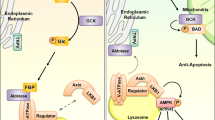Abstract
All living cells maintain cellular homeostasis to run biochemical reactions at constant speed. When certain nutrients become limiting, an interplay between sensors and transporters is required to restore cellular homeostasis. Here I will discuss several examples of how the cellular need for essential nutrients, such as lactose, pyruvate, and K+ is sensed and how the signals are transduced into the synthesis of the corresponding transporters.
Similar content being viewed by others
Literatur
Novick A, Weiner M (1957) Enzyme induction as an all-or-none phenomenon. Proc Natl Acad Sci USA 43:553–566
Ulrich LE, Koonin EV, Zhulin IB (2005) One-component systems dominate signal transduction in prokaryotes. Trends Microbiol 13:52–56
Choi PI, Cai L, Frieda K et al. (2008) A stochastic single-molecule event triggers phenotype switching of a bacterial cell. Science 322:438–442
Ozbudak EM, Thattai M, Lim HN et al. (2004) Multistability in the lactose utilization network of Escherichia coli. Nature 427:737–740
Behr S, Fried L, Jung K (2014) Identification of a novel nutrient-sensing histidine kinase/response regulator network in Escherichia coli. J Bacteriol 196:2023–2029
Behr S, Kristoficova I, Witting M et al. (2017) Identification of a high-affinity pyruvate receptor in Escherichia coli. Sci Rep 7:1–10
Vilhena C, Kaganovitch E, Shin JY et al. (2018) A single-cell view of the BtsSR/YpdAB pyruvate sensing network in Escherichia coli and its biological relevance. J Bacteriol 200:1–13
Schlegel S, Genevaux P, de Gier J-W (2015) De-convoluting the genetic adaptations of E. coli C41 (DE3) in real time reveals how alleviating protein production stress improves yields. Cell Reports 10:1758–1766
Charbonnier T, Le Coq D, McGovern S et al. (2017) Molecular and physiological logics of the pyruvate-induced response of a novel transporter in Bacillus subtilis. mBio 8:233
Hamann K, Zimmann P, Altendorf K (2008) Reduction of turgor is not the stimulus for the sensor kinase KdpD of Escherichia coli. I Bacteriol 190:2360–2367
Laimins LA, Rhoads DB, Epstein W (1981) Osmotic control of kdp operon expression in Escherichia coli Proc Natl Acad Sci USA 78:464–468
Stock C, Hielkema L, Tascón I et al. (2018) Cryo-EM structures of KdpFABC suggest a K+ transport mechanism via two inter-subunit half-channels. Nat Commun 9:4971
Schramke H, Tostevin F, Heermann R et al. (2016) A dual-sensing receptor confers robust cellular homeostasis. Cell Reports 16:213–221
Levy S, Kafri M, Carmi M et al. (2011) The competitive advantage of a dual-transporter system. Science 334:1408–1412
Author information
Authors and Affiliations
Corresponding author
Additional information
Kirsten Jung 1980–1988 Biochemiestudium und Promotion an der Universität Leipzig. 1989–1991 Elternzeit und wissenschaftliche Mitarbeiterin an der Universität Leipzig. 1992–1994 Postdoktorandenaufenthalt am Howard Hughes Medical Institute, University of California, Los Angeles, USA. 1994–2002 wissenschaftliche Mitarbeiterin und Heisenbergstipendiatin an der Universität Osnabrück. 2002 Professorin für Mikro biologie an der TU Darmstadt. Seit 2004 Lehrstuhlinhaberin für Mikrobiologie an der LMU München.
Rights and permissions
About this article
Cite this article
Jung, K. Zusammenspiel von Sensoren und Transportern unter Nährstofflimitation. Biospektrum 25, 488–491 (2019). https://doi.org/10.1007/s12268-019-1084-0
Published:
Issue Date:
DOI: https://doi.org/10.1007/s12268-019-1084-0




